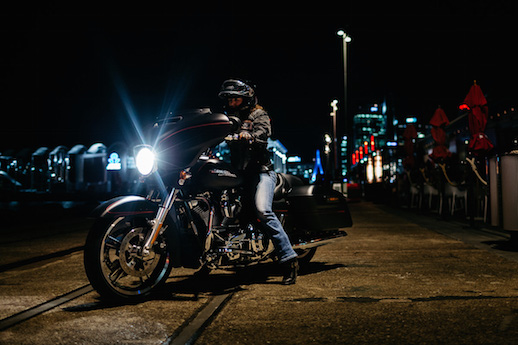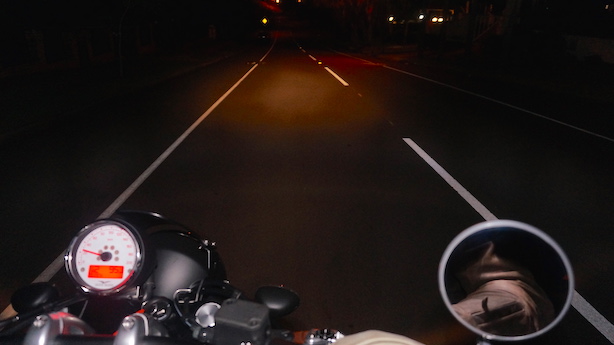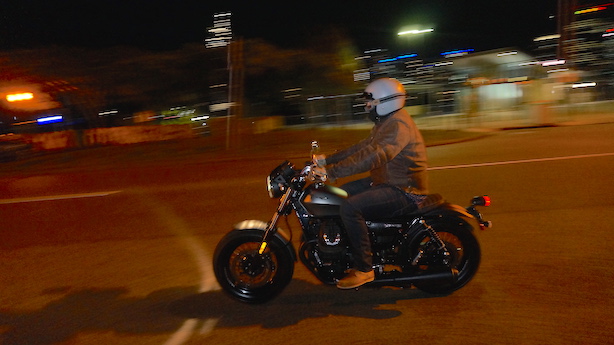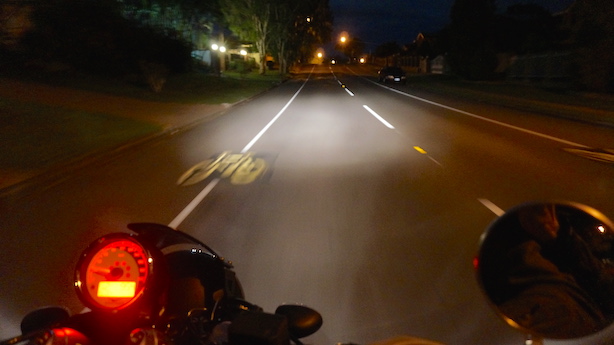Not many motorcyclists purposely go out for a ride at night, but it’s exhilarating and we should do it more often to brush up on our skills just in case we are caught out still riding after sunset.
One of the joys of riding is isolating yourself in a bubble of mediation. These cocooning feelings of isolation are heightened in the dark where your vision is restricted to a tunnel of headlight-lit road.
However, a recent Monash University Accident Research Centre report says that the odds of a more severe injury crash outcome are almost a third higher in dark conditions.
Even twilight and early morning have their dangers with a 12% higher crash risk.
There are hidden dangers out there in the dark and you need to arm yourself with special skills to survive.
Here are our tips for surviving and enjoying being a night rider:
1 Vision
Obviously your vision is restricted at night. So make sure you clean your visor and/or windshield very carefully. What may look clean in the daylight could be dazzling and blinding when a car’s headlights hit it, so remove all those smears. Clean with a dedicated cleaner, but make sure you wipe it all off. If you can dim your instrument lights, that will prevent distracting glare on your windscreen and visor
2 Yellow glasses
Some people swear by yellow-lens glasses, saying they restore the three dimensions that become flat in headlights, reduce glare, improve contrast and give you better depth perception. However, be very careful of adding any tint to an already dark situation! If you wear prescription glasses or wear goggles, you can ask for an AR coating (AR stands for anti-reflective or anti-glare). Otherwise, don’t wear glasses unless you have no visor.
3 Lights
Aiding your vision is a decent spread and depth of headlights. If your standard headlights are not up to par (and they too-often aren’t), you can supplement them for more powerful units or even a brighter bulb (halogen, xenon or LED). But be aware that some people don’t see as well with these white lights. Also, be aware of the laws regarding modifying headlights. There are also different laws in varying states about adding auxiliary driving or fog lights. Usually they have to be attached to your high beam switch only and/or be on a separate switch. Fog lights can only be used legally in foggy conditions.
4 Cornering
Headlights are focussed straight ahead, so when you corner, you illuminate the outside of the corner, not the apex where you want to go. The BMW K 1600 has lights that turn into the corners and there are others such as KTM which have LED lights that light up the inside of the corner when you turn. You can also now buy aftermarket lights that illuminate the inside of a corner. But if you don’t have these, be aware that all corners at night are riddled with blind spots. So don’t use all the corner as the apex and exit could be covered in gravel, oil or water.
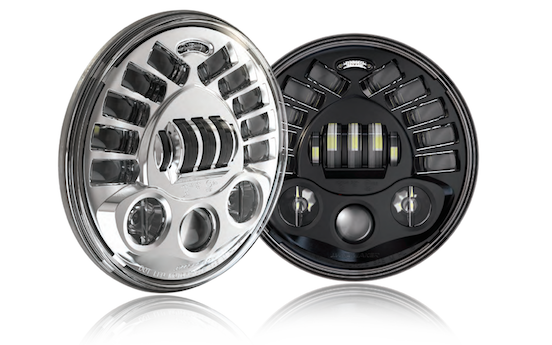
5 Road surface
Which brings us to the road surface. Normally you scan the road surface for gravel, oil and diesel spills, water, sewer covers, potholes, bumps, ruts, etc. At night, you may not see them until it’s too late, so ride as if there are obstacles up ahead.
6 Adjust your speed
Consequently you should slow down to a speed where you can stop within the reach of your headlights. Would you ride with your eyes closed even for a few short seconds? Well, if you ride too fast to stop within your lights’ reach, then that’s exactly what you are doing!
7 Be seen
You and your bike will be more difficult to see at night, especially if you wear black leathers and ride a dark bike. We are not advising you wear hi-vis clothes as these can actually dazzle and transfix drivers’ attention. However, a bit of reflective 3M tape and stitched items on your gear and your bike will draw a bit of extra attention. Make sure your fork and tail reflectors are cleaned and that your lights are cleaned and working properly. It’s also important to move around within your lane as your headlight will attract a bit more attention from other traffic. Never ride in another motorist’s blind spot.
8 Riding style
Because you are unaware of what is on the road ahead, you should treat the road surface as if it is wet. Check out our tips for riding in the wet here. The main tip is to be smooth – brakes, throttle and steering.
9 Pillion adjustments
If you have a pillion, it may change the level of your headlights which could dazzle other motorists. You may think that should not concern you, but if an oncoming motorist is dazzled, their natural reaction is to flash their lights at you which dazzles you! If another motorist does flash their lights, don’t look directly at them. Stare down at the road that you can see. You might even like to put your hand up or use your helmet peak (if you have one), to veil their lights.
10 Livestock, wildlife, insects and pedestrians
If you think roos are difficult to spot in the daytime, try night time! And it’s not just wildlife you have to watch out for, but also stray stock and stray pedestrians dressed in black and staring at their mobile phones. At least animals will look at your headlights and you will spot the reflections in their retinas, so be on the lookout for those little spots of reflected light. Bugs are another nighttime animal hazard. They are attracted to your headlights and will smear your visor and windscreen, so take some baby wipes or visor cleaner and a clean rag.


